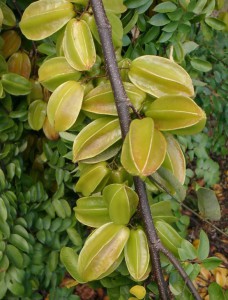
When fruits are in season trucks travel the streets fully loaded with their produce with loudspeakers blaring away with what’s available. They also stop on main streets advertising their wares. This is particularly true with Durian, Mangosteen, Rambutan and Lychee. These trucks are a very good place to get fresh fruit in Hua Hin. The daily markets, such as Dinosaur (Sunday and Wednesday), Pae Mai (Tuesday), and Rim Klong (almost every day) also usually have the freshest fruits available. (Click on the name for a map to the market.) Chatchai Market (daily) has fresh fruit and is convenient but the prices are a tad dearer. The superstores: Makro,Tesco and Big C also carry fruit but their standards can vary from day-to-day. Regardless of where you buy, ONLY purchase fruit that you can select yourself.
Thai Fruits
Mangosteen มังคุค Garcinia mangostana
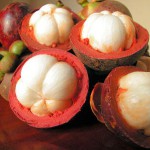
Mangosteen (mahngkoot) is often called the Queen of Fruits, due to its “cooling” properties, in contrast to the King of Fruits, Durian, with it’s “heatiness”. The fruiting seasons of the two coincide and they make a very nice combination. The husk or exocarp of the Mangosteen is a leathery purple shell which, when opened, reveals the soft, white fruit which is quite delicate and consists of 4-8 segments, the larger of which contain seeds. The fragrant, fleshy fruit is both sweet and tangy.
Rambutan เงาะ Nephelium lappaceum
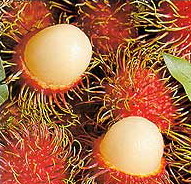
The fruit of the Rambutan (ngaw) tree is usually bright red though there are also orange and yellow varieties. Rambut means hair in IndoMalay and the fruit could be described as a golf-ball sized red fruit covered in green Velcro fibers.
Breaking open the skin reveals a fleshy translucent or whitish fruit containing a large seed. The fruit is sweet with a mildly acidic flavor.
The best Rambutan are said to come from Surat Thani province where they were first planted in 1926.
Rambutan is easily canned and thus available throughout the world in a sweet syrup.
Durian ทุเรียน Durio zibethinus and others
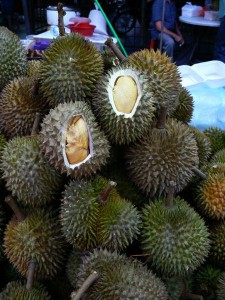
Weighing in at around 4 pounds and 1 foot long and 6 inches wide this ovoid, thorn-covered fruit looks more like something that would be dropped out of a B-52 at high altitude rather than fetch top dollar in the markets of Southeast Asia.
You either love Durian (dturian) or hate it. Most locals love it and most Westerners can’t believe that anyone could eat such a foul smelling mistake of nature. Obviously, those here don’t care what the Farangs think as Durian is one of the most popular fruits in Thailand. There are several varieties in Thailand with different regions known for their special fruits.
To quote the two sides of the controversy:
In 1856, the British naturalist Alfred Russel Wallace provides a much-quoted description of the flavour of the Durian:
“The five cells are silky-white within, and are filled with a mass of firm, cream-coloured pulp, containing about three seeds each. This pulp is the edible part, and its consistence and flavour are indescribable. A rich custard highly flavoured with almonds gives the best general idea of it, but there are occasional wafts of flavour that call to mind cream-cheese, onion-sauce, sherry-wine, and other incongruous dishes. Then there is a rich glutinous smoothness in the pulp which nothing else possesses, but which adds to its delicacy. It is neither acid nor sweet nor juicy; yet it wants neither of these qualities, for it is in itself perfect. It produces no nausea or other bad effect, and the more you eat of it the less you feel inclined to stop. In fact, to eat Durians is a new sensation worth a voyage to the East to experience. … as producing a food of the most exquisite flavour it is unsurpassed.”
But travel and food writer Richard Sterling says:
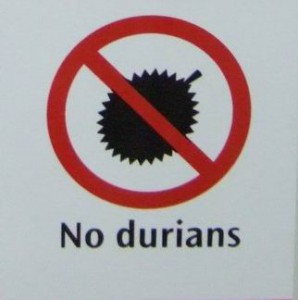
“… its odor is best described as pig-shit, turpentine and onions, garnished with a gym sock. It can be smelled from yards away. Despite its great local popularity, the raw fruit is forbidden from some establishments such as hotels, subways and airports, including public transportation in Southeast Asia.”
And Anthony Bourdain, while a lover of Durian, relates his encounter with the fruit as thus:
“Its taste can only be described as…indescribable, something you will either love or despise. …Your breath will smell as if you’d been French-kissing your dead grandmother.”
Durian is also available in paste form, and Durian flavored cream cookies are common. Local and international ice cream companies market Durian flavored ice cream which has much of the taste without the strong aroma.
Pomelo ส้มโอ Citrus maxima or Citrus grandis
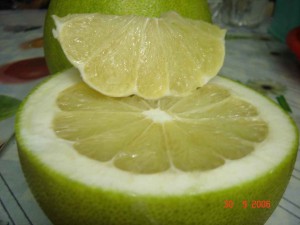
The Pomelo (som oh) is an ancestor of the grapefruit and is the largest citrus fruit ranging in size from that of a large grapefruit to the
diameter of a basketball. It tastes like a sweet, mild grapefruit with little of the grapefruit’s bitterness though the membranes of the
segments are quite bitter. The rind is very thick.
Pomelo is normally eaten fresh by itself but it also used in spicy salads. When eaten raw, it is often dipped in a mixture of salt, sugar and chili flakes.
Rose Apple ชมพู่ Syzygium malaccense
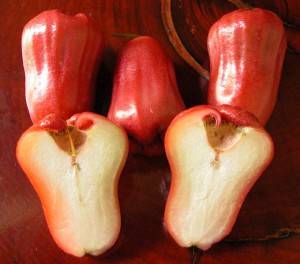
chompooThe Rose Apple, Mountain Apple (champoo) is very common in Thailand. From bright red to pink or green, the Rose Apple is bell shaped and similar in texture to an apple but sweeter.
Most often eaten fresh but also nice mixed with shrimp in a spicy salad (ยำชมพู่)
Lychee ลิ้นจี่ Litchi chinensis
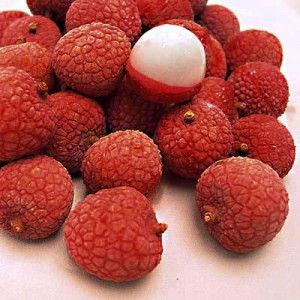
The bright red fruit of the Lychee (linchee) is just smaller than a golf ball with a rind similar to the golf ball but with pimples rather the dimples. Firm pressure with the thumbs breaks the rind and reveals the white fleshy fruit that is very sweet and rich in vitamin C. The seed inside the fruit is not edible.
The fruit is available only a few months a year but is easily canned and is often served as dessert in Thai and Chinese restaurants.
There are many cultivars of the two main species and purists in various Asian countries claim theirs are the best and sweetest.
Banana (กล้วย) Musa sp.
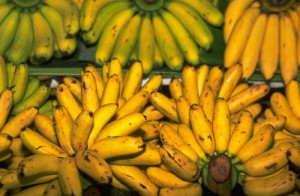
There are many types of banana (gluay) in Thailand but the most popular are Gluay Hom (กล้วยหอม) and Gluay Khai (กล้วยไข่). Bananas are available year around and are most often eaten when ripe but are also eaten green in dishes like Naem Nuang (แหนมเนือง) or nem nướng. Fried banana (กล้วยแขก) are also popular and very well-known. Dried banana chips are also a tasty snack.
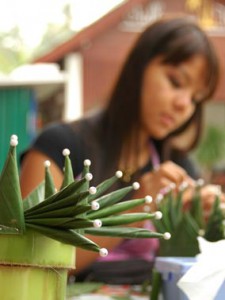
Banana tree stalks are also used in making Kratongs (กระทง) which are used during the Loi Kratong (ลอยกระทง) Festival during November. Banana leaves (ใบตอง)are often used in cooking as in wrapping fish to be steamed or grilled over an open fire. The bright red blossom or inflorescence of the banana (หัวปลี) is also eaten as a vegetable, in salads such as SomTom or even deep-fried.
Coconut มะพร้าว Cocos nucifera
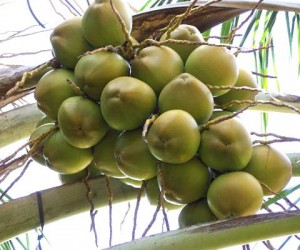
Coconuts (maphrao) are among the most versatile of fruits (they are actually seeds of the coconut tree) with many, many uses. The meat can be eaten fresh or dried, either as a sweet or in savory dishes. The water is sweet and very nutritious and provides an isotonic electrolyte balance and can even be used as an intravenous fluid. Coconut milk, which is made from processing grated coconut and mixing it with warm water is used in much Asian cooking. Southern Thai curries almost always have coconut milk while curries from Northeast seldom use it.
The coconut husk is used as a potting medium for plants and used as mattress stuffing.
The coconut shell can be used in making jewelry and is a good source of charcoal.
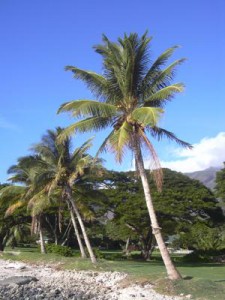
Palmwood from the trunk is increasingly used in furniture making and entire trunks are often used in making bridges due to their straightness and water and salt resistance.
Coconut oil extracted from fresh coconut meat is a high quality oil used in cosmetics, medicines and bio-fuels.
Custard Apple, Sugar Apple or Soursop น้อยหน่า Annona reticulata
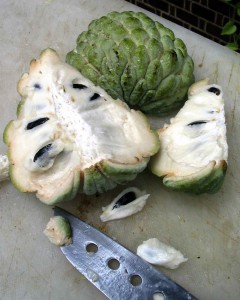
The Custard Apple or soursop (noi na) is sweet but very seedy. The skin of the ripe fruit is green with many segments. It is said to be an anti-oxidant and will strengthen your ability to fight infection and disease.
In Thailand, the term noi na is also used to refer to a hand grenade due to the similarity in shape and size.
Plum Mango มะปราง Bouea macrophylla
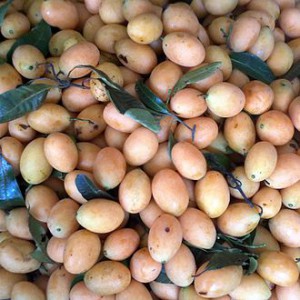
The Plum Mango (ma prang) is related to the mango and he entire fruit, including its single seed, is edible. The fruit range from sweet to sour in flavour, and have a light smell of turpentine.
Star Gooseberry มะยม Phyllanthus acidus
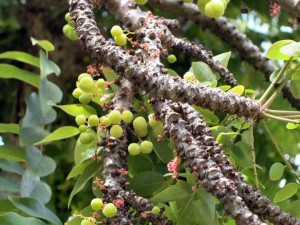
The Star Gooseberry (ma yom) is very common around Thai houses. The tree is said to bring good fortune to the residents and it produces many small tart fruits in a short time. It makes a small shade tree but in fruiting season drops fruits almost too fast to keep up with, even with children in the house, among whom the fruit is very popular. It is very high in Vitamin C and is said to straighten hair!
Guava ฝรั่ง Psidium guajava
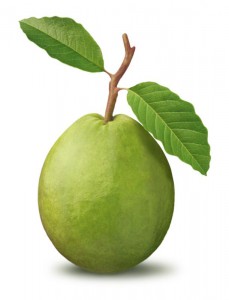
One seldom sees a ripe Guava (falang) in Thailand as Thais prefer to the fruit raw, dipped in salt or sugar mixed with dried chilis. An unripen Guava reminds one of the texture of a ripe apple. Guava juice is readily available and is rich in vitamin C.
Jackfruit ขนุน Artocarpus heterophyllus
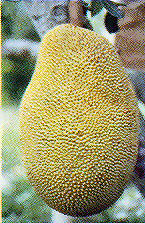
If a Durian resembles a small bomb then the Jackfruit (kanoon) must be the Mother of them all. Weighing up to 80 pounds and a yard long, the Jackfruit is the largest tree borne fruit in the world. Broken open, the Jackfruit reveals dozens of large seeds covered with a sweet yellow sheath which has a taste similar to pineapple but milder and less juicy. It is said that the flavor of Juicy Fruit chewing gum comes from the Jackfruit.
The fruit is normally eaten raw but can also be dried and made into chips or cooked and added to curries.
A dye from the heartwood of the Jackfruit tree is used by forest monks to give their robes the traditional off-brown color.
Jujube พุทรา Ziziphus zizyphus
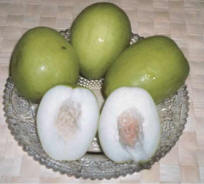
The freshly harvested Jujube (phsaa) as well as the candied dried fruits are often eaten as a snack. The fruit is an edible oval drupe 1.5-3 cm long; when immature it is smooth-green, with the consistency and taste of an apple, maturing dark red to purplish-black and eventually wrinkled, looking like a small date.
Langsart ลางสาด Lansium domesticum
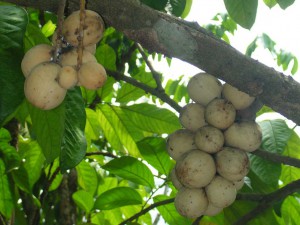
Langsart (langsart) are a sweet fruit with a pale brown skin with an inner stone which is quite bitter. Langsart grows on a tree of medium height. The leaf pattern consists of one large leaf with 5-7 small leaves. The fragrant yellow petals hang in pendulous spikes and start blooming in midsummer.The fruit hang in bunches of 8 to 20 pieces. The smooth outer skin is a dirty yellow color. Under the thin peel, which exudes a milky sap, are about five white or pinkish segments unequal in size. Most segments are sweet, but one or two contain a viable seed and are very bitter to the taste. Some people enjoy the contrast of flavors.
Longan ลำไย Dimocarpus longan
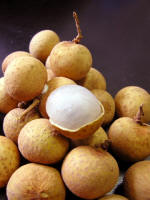
The longan (lamyai) or “dragon eyes” is so named because of the fruit’s resemblance to an eyeball when it is shelled (the black seed shows through the translucent flesh like a pupil/iris). The seed is small, round and hard and closely allied to the glamorous lychee. The fruit is edible, and is often used in East Asian soups, snacks, desserts, and sweet-and-sour foods, either fresh or dried, sometimes canned with syrup in supermarkets. The seeds of fresh longan can be boiled and eaten, with a distinctive nutty flavor.
Mango มะม่วง Mangifera sp.
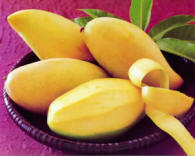
Thailand and Hua Hin are well-known for Mango and sticky rice ข้าวเหนียวมะม่วง. The sweet mango and the coconut milk and sticky rice just can’t be beat as a dessert and is readily available in Hua Hin. The most well-known shop is across the street from the Hilton Hotel to the north. This shop normally has ripe mangoes throughout the year though they can get a little expensive during the off-season. There are also stalls in Chatchai Market and across the street on Phetkasem Rd. There are several cultivars of mango with some sweeter and some more sour. Some are eaten with a salt and chili dry dip. There is also a Three Season cultivar which produces year around.
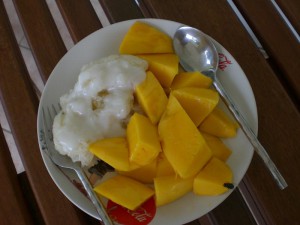
Local and franchise ice cream shops also have fresh mango and sticky rice promotions during the season, served with mango ice cream, of course.
Unripe mangos are often used in salads. Yam Pla Duk Fu is fried fish flakes mixed with an unripe mango salad that is great with beer on a hot day.
Pineapple สับปะรด Ananas comosus
Thailand is a large producer of pineapple, both for local consumption and for export. Major international canneries are located here in many parts of the country. Dole cans pineapple in Hua Hin. Many of the golf courses around Hua Hin were once pineapple fields and where ever you travel in the area you will see pineapple, often grown next to sugar cane fields as they share common environmental needs.
Santol กระท้อน Sandoricum koetjape
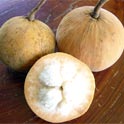
Sapodilla ละมุด Manilkara zapota
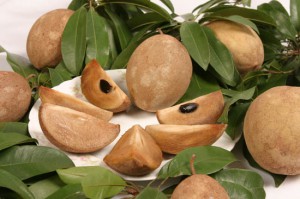
Tamarind มะขาม Tamarindus indica
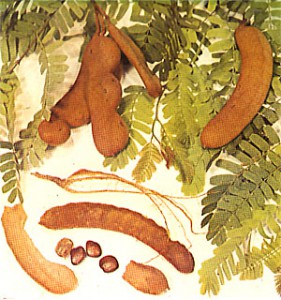
Dragonfruit แก้วมังกร Hylocereus sp
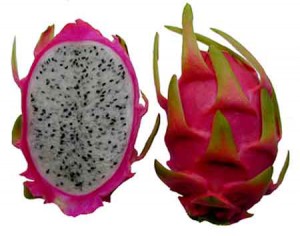
These fruits grow off the long arms of a cactus found in southern China and SE Asia.
Star fruit มะเฟือง Averrhoa carambola
